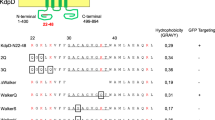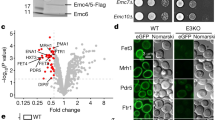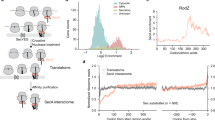Abstract
TRANSLOCATION of proteins across the endoplasmic reticulum (ER) membrane represents the first step in the eukaryotic secretory pathway. In mammalian cells, the targeting of secretory and membrane protein precursors to the ER is mediated by signal recognition particle (SRP), a cytosolic ribonucleoprotein complex comprising a molecule of 7SL RNA and six polypeptide subunits (relative molecular masses 9, 14, 19, 54, 68 and 72K)1. In Sac-charomyces cerevisiae, a homologue of the 54K subunit (SRP54)2,3co-purifies with a small cytoplasmic RNA, scRl (refs 4, 5). Genetic data indicate that SRP54 and scRl are involved in translocation in vivo, suggesting the existence of an SRP-like activity in yeast5,6. Whether this activity requires additional components similar to those found in mammalian SRP is not known. We have recently reported a genetic selection that led to the isolation of a yeast mutant, sec65-l, which is conditionally defective in the insertion of integral membrane proteins into the ER7. Here we report the cloning and sequencing of the SEC65 gene, which encodes a 31.2K protein with significant sequence similarity to the 19K subunit of human SRP (SRP19)8. We also report the cloning of a multicopy suppressor of sec65-l, and its identification as the previously definedSRP54gene, providing genetic evidence for an interaction between these gene products in vivo
This is a preview of subscription content, access via your institution
Access options
Subscribe to this journal
Receive 51 print issues and online access
$199.00 per year
only $3.90 per issue
Buy this article
- Purchase on Springer Link
- Instant access to full article PDF
Prices may be subject to local taxes which are calculated during checkout
Similar content being viewed by others
References
Walter, P. & Blobel, G. Nature 99, 691–698 (1982).
Hann, B. C. Poritz, M. A. & Walter P. J. Cell Biol. 109, 3223–3230 (1989).
Amaya, Y., Nakano, A., Ito, K. & Mori, M. J. Biochem. 107, 457–463 (1990).
Felici, F., Cesareni, G. & Hughes, J. M. Molec. Cell Biol., 9, 3260–3268 (1989).
Hann, B. C. & Walter, P. Cell 67, 131–144 (1991).
Amaya, Y. & Nakano, A. FEBS Lett. 283, 325–328 (1991).
Stirling, C. J. Molec. Biol. Cell (in the press).
Lingelbach, K. et al. Nucleic Acids Res. 16, 9431–9442 (1988).
Orr-Weaver, T. L., Szostak, J. W. & Rothstein, R. J. Proc. natn. Acad. Sci. U.S.A. 78, 6354–6358 (1981).
Hann, B. C., Stirling, C. J., & Walter, P. Nature 356, 532–533 (1992).
Hill, J. E., Myers, A. M., Koerner, T. J. & Tzagoloff, A. Yeast 2, 163–168 (1986).
Sikorski, R. S. & Hieter, P. Genetics 122, 19–27 (1989).
de Montigny, J., Belarbi A., Hubert, J. C. & Lacroute, F. Molec. gen. Genet. 215, 455–462 (1989).
Vieira, J. & Messing, J. Meth. Enzym. 153, 3–11 (1987).
Henikoff, S. Meth. Enzym. 155, 156–165 (1987).
Struhl, K. Nucleic Acids Res. 13, 8587–8601 (1985).
Parker, R. et al. Molec. Cell Biol. 8, 3150–3159 (1988).
Woods, A. et al. J. Cell Sci. 93, 491–500 (1989).
Nilsson, B. L. Abrahmsen, L. & Uhlen, M. EMBO J. 4, 1075–1080 (1985).
Deshaies, R. J. & Schekman, R. Molec. Cell Biol. 10, 6024–6035 (1990).
Author information
Authors and Affiliations
Rights and permissions
About this article
Cite this article
Stirling, C., Hewitt, E. The S. cerevisiae SEC65 gene encodes a component of yeast signal recognition particle with homology to human SRP19. Nature 356, 534–537 (1992). https://doi.org/10.1038/356534a0
Received:
Accepted:
Issue Date:
DOI: https://doi.org/10.1038/356534a0
This article is cited by
-
Filamentous fungi-like secretory pathway strayed in a yeast system: peculiarities of Yarrowia lipolytica secretory pathway underlying its extraordinary performance
Applied Microbiology and Biotechnology (2019)
Comments
By submitting a comment you agree to abide by our Terms and Community Guidelines. If you find something abusive or that does not comply with our terms or guidelines please flag it as inappropriate.



